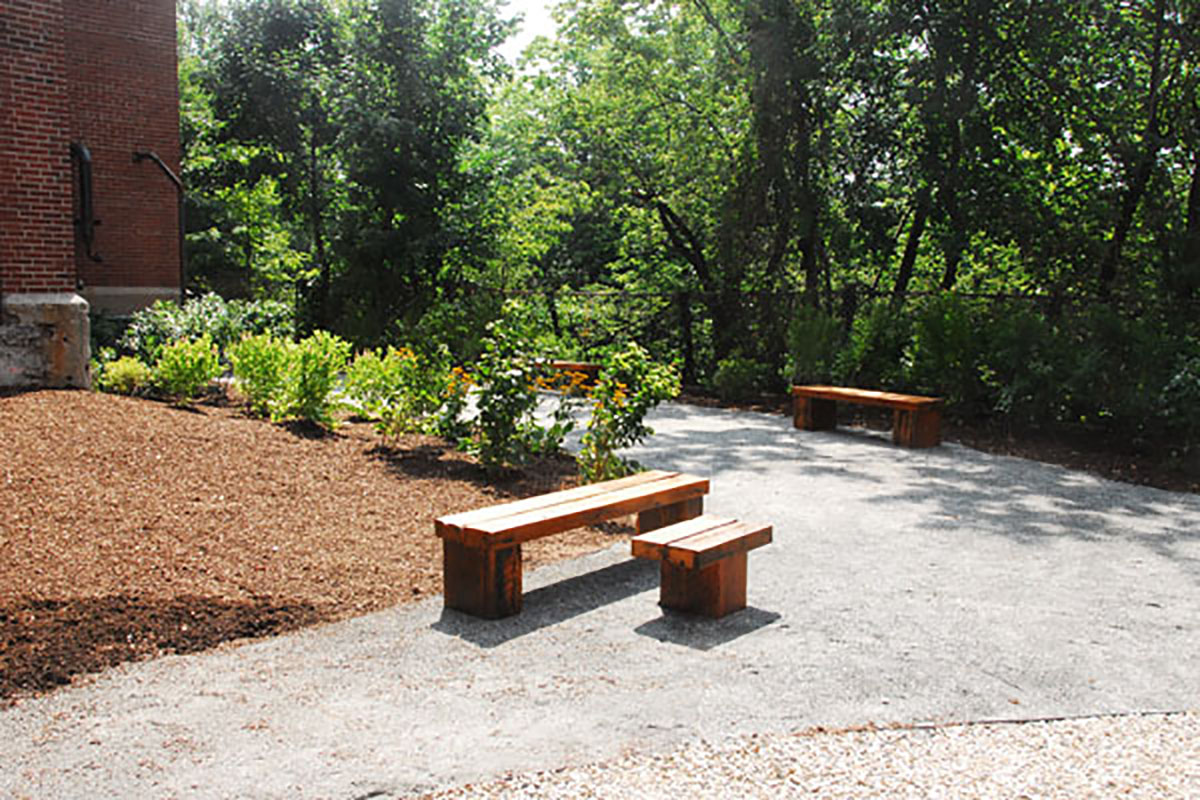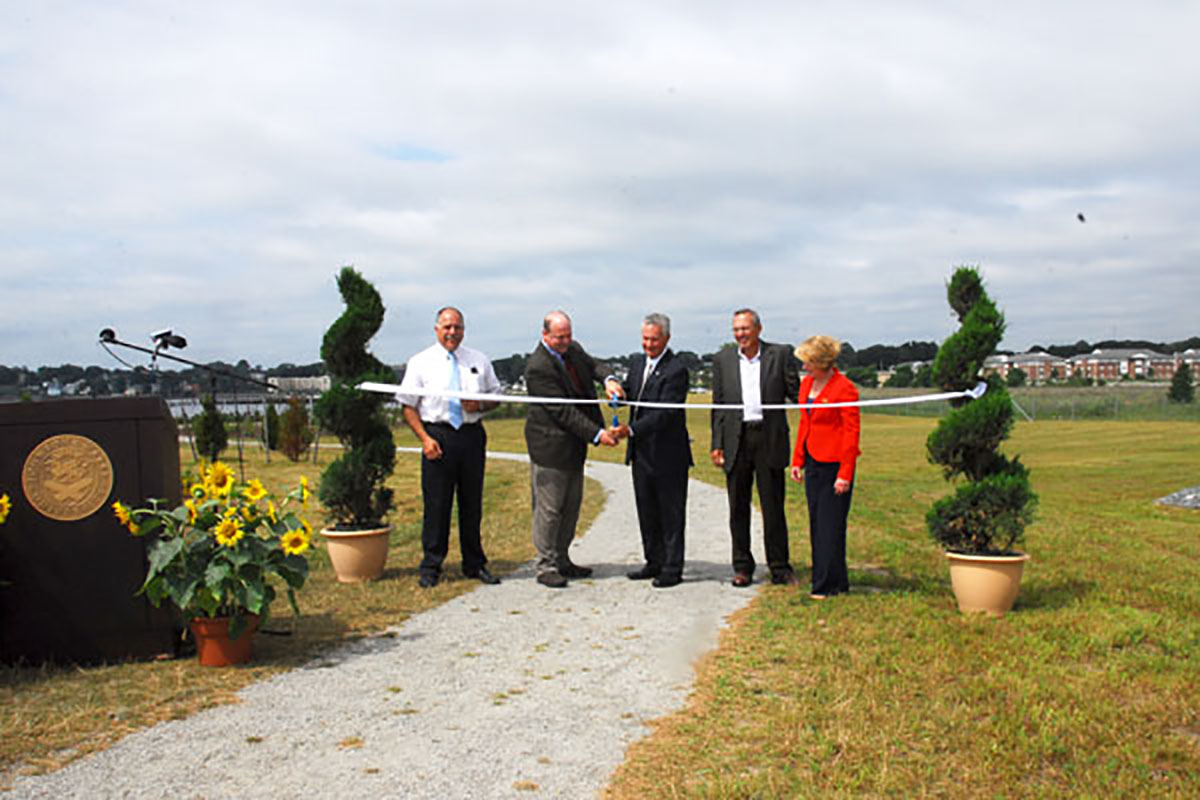
RI Coastal Resources Management Council
...to preserve, protect, develop, and restore coastal resources for all Rhode Islanders

...to preserve, protect, develop, and restore coastal resources for all Rhode Islanders
New UCG projects moving forward
July 5, 2016, Wakefield – When the Urban Coastal Greenways Policy was adopted by the R.I. Coastal Resources Management Council in fall of 2006 as part of the Metro Bay Special Area Management Plan (SAMP), the response from businesses and developers in the region was overwhelmingly positive.
In May 2007, the CRMC and American Locomotive Works developer Struever Bros. Eccles & Rouse, unveiled a newly designed sign and logo for the UCG, and touted the 2000 linear feet of urban public access along the Woonasquatucket River approved by the CRMC as part of the project. At the time, the UCG policy had approved a total of about 6100 linear feet of new shoreline access in the SAMP area, which includes the cities of Cranston, East Providence, Providence, and Pawtucket.
Then the economy fell into a deep recession, bringing many of the projects to a standstill. With the economy in Rhode Island on the uptick, however, several new Metro Bay projects are under construction, namely Village on the Waterfront and Kettle Point, both on the East Providence shoreline. When these projects are completed, more than 2.5 miles of new public access (13,450 linear feet) will be available to the public in the Metro Bay urban area.
“A lot of projects folded when the economy collapsed in 2008”, said CRMC Coastal Policy Analyst James Boyd. “A lot of projects were permitted, and then went up for sale but didn’t sell.” One example – GeoNova in East Providence, which was originally slated for a $200 million condominium development called East Pointe on the Seekonk River, with a 1,800-linear-foot UCG, went into receivership and was the subject of litigation for years. The property now appears to have new investors. During the recession, Struever Bros. was forced to scale back its extensive plans to revitalize the American Locomotive Works complex, and in 2013 sold the property to Foundry Associates and then left Rhode Island. At the time, Struever had constructed 1,500 of the 2,000 planed linear feet of the UCG; there are now plans to construct the remaining 500 feet with further site development.
Johnson & Wales University has constructed a 1,600-linear-foot UCG abutting its athletic fields at Fields Point starting at Save The Bay Drive in Providence. The CRMC and Johnson & Wales University officials held a ribbon-cutting ceremony in July 2011. The Tockwotton Home in East Providence has also completed construction of its 400-linear-foot UCG along the Seekonk River.
“The UCG has definitely increased public access along the shoreline” in the Metro Bay area, Boyd said. Some of these predominantly (formerly) industrial properties have been in continuous use for 100 years or more. “We can easily say that public access along section of the Providence and Woonasquatucket Rivers made available through permitting action opens them up for the first time since the industrialization of the waterfront.”
The CRMC permitted the Village on the Waterfront in East Providence, a 26-acre mixed-use development to include 2,500 linear feet of public access under the UCG policy, in the fall of 2011. The site, previously used for industrial purposes for nearly a century, is currently being remediated (at least 27 petroleum storage tanks were present on the site and removed in the late 1980s and early 1990s).
At Kettle Point Development in East Providence, 407 residential units and a planned 4,000 linear feet of public access and Urban Coastal Greenway are planned. The project, permitted in 2015, is currently under construction. The UCG will include pedestrian paths, public parking, rehabilitation of one of the area’s existing piers, and general public access.
National Grid, along with the University of Rhode Island, is working to redevelop the old Narragansett Electric South Street Substation on Eddy Street in Providence, which will include the construction of 750 linear feet of public access north of the Point Street Bridge. The UCG in this location will also link with the two park parcels and soon-to-be constructed footbridge as part of the I-195 Redevelopment Area.
“This is a wonderful opportunity for the public to gain increased access to the shoreline,” Boyd said. “That wouldn’t have happened without the CRMC’s Metro Bay (SAMP) Urban Coastal Greenway program.”

A view of part of the Urban Coastal Greenway at the American Locomotive Works site in Providence. (July 2007)

Officials cut the ribbon, signaling the official opening of the Johnson & Wales Urban Coastal Greenway. From left to right are: Terry Gray, RI DEM, Grover Fugate, CRMC, JWU Chancellor John Bowen, Merlin DeConti, JWU senior vice president of facilities management, and JWU President Mim L. Runey. (July 2011)
About the Metro Bay SAMP and UCG
The Metro Bay SAMP, the CRMC’s fifth, encompasses the cities of Cranston, East Providence, Providence, and Pawtucket. This region is a largely untapped natural resource and economic engine. It was the site of industrialization and progress and over the years has become outdated and underutilized. The cities are now acting to make this region of Narragansett Bay a more appealing place to live and work by improving the economic, social and environmental resources of the working waterfront; attracting major developers with more predictable and efficient permitting; and providing recreation and access to the water.
The UCG is a new regulatory approach for coastal vegetative buffers in the urbanized environment of northern Narragansett Bay, and is intended for projects bordering the Providence, Seekonk, Moshassuck and Woonasquatucket Rivers. The purpose of the UCG is to provide a mechanism to redevelop the urban waterfront of the Metro Bay region in a way that integrates economic development with expanded public access along and to the shoreline, as well as the management, protection and restoration of valuable coastal habitats.